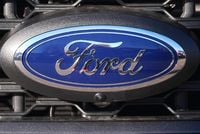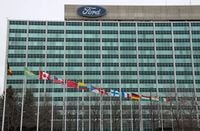Ford Motor Company is once again in the spotlight after announcing a substantial safety recall affecting its popular Ranger pickup trucks. The recall, which covers 100,900 vehicles from the 2024 through 2026 model years, centers on a defect with the side curtain airbags—a crucial safety feature designed to protect occupants in the event of a crash. According to documents filed with the National Highway Traffic Safety Administration (NHTSA), the airbags in these vehicles may tear when deployed, potentially increasing the risk of injury to drivers and passengers.
The issue was discovered during a June 2025 crash test conducted by the NHTSA. As reported by multiple outlets including Car and Driver, while the Ranger passed the initial test, a slit was found on one of the side curtain airbags after deployment. The underlying cause, as described in the recall notice, is that the airbag can come into contact with the interior B-pillar’s inner reinforcement flange during deployment, leading to a tear. This problem affects both the left and right side airbags in all Ranger pickups manufactured between December 9, 2022, and July 29, 2025.
Ford responded quickly to the NHTSA’s findings, issuing the recall in August 2025. The company has since sent out letters to all known owners of the affected vehicles. The initial notification, mailed on September 5, 2025, explained the nature of the defect and outlined the next steps. In the letter, Ford stated that a permanent fix—protective shields designed to prevent the airbags from making contact with the problematic flange—would be installed by dealers free of charge. However, there’s a catch: the parts required for this repair are not yet available. Ford expects the shields to be ready in the fourth quarter of 2025 and has promised to notify owners again when it’s time to schedule a service appointment.
In the meantime, Ford is urging owners to bring their vehicles to local dealerships for inspection. While the permanent shields are still in production, dealers can at least verify whether a vehicle is affected and prepare for the eventual installation. For those with questions or concerns, Ford’s customer service line is open at 1-866-436-7332, and the NHTSA’s safety hotline is available at 1-888-327-4236. Owners can also check the NHTSA recall website or Ford’s own recall site for the latest updates on the availability of the fix.
Despite the seriousness of the defect, Ford has stated that it is not aware of any warranty claims or customer reports related to the airbag issue so far. As of now, the defect has been addressed in Ranger models produced since July 29, 2025, meaning newly manufactured vehicles are not affected by the recall. This is likely to provide some reassurance to prospective buyers, but for current owners, the wait for a permanent solution continues.
This latest recall marks the third major recall involving the Ranger in 2025 alone. In August, Ford recalled approximately 21,700 SUVs and sedans due to failing lights and turn signals, according to the NHTSA. Earlier in May, more than 273,000 Ford SUVs were recalled over brake line issues that could cause a fluid leak, while at the start of April, over 33,000 SUVs were recalled due to fuel leak risks that increased the chance of an engine fire. The Ranger itself was previously recalled in August for a brake booster defect and in May for a rearview camera issue. There was also a smaller recall for a steering problem affecting a handful of 2024–2025 model pickups.
The string of recalls has put Ford under increased scrutiny, both from regulators and from customers who rely on the automaker’s reputation for building durable, safe vehicles. While recalls are not uncommon in the automotive industry—especially as vehicles become more technologically complex—the frequency and scale of Ford’s actions in 2025 have raised eyebrows. Some industry observers, like longtime automotive journalist Laura Sky Brown, see these recalls as a necessary step to maintain safety standards and consumer trust. Brown, who has been involved in automotive media for decades, emphasizes the importance of transparency and swift action when safety is at stake.
For affected Ranger owners, the recall process is straightforward but requires patience. After receiving the initial notification letter, owners are advised to monitor their mail and the official recall websites for news about the availability of repair parts. Once the protective shields are ready, Ford will send a second letter with instructions on how to schedule a service appointment at a local dealership. All inspections and repairs related to the recall will be performed at no cost to the owner.
The NHTSA, for its part, has praised Ford’s proactive response to the airbag defect. The agency encourages all vehicle owners to stay informed about recalls and to take prompt action when notified. “Recalls are about fixing safety problems before they result in injuries or fatalities,” an NHTSA spokesperson said, urging drivers not to delay once the fix is available.
It’s worth noting that the side curtain airbag is a vital safety component, designed to protect occupants’ heads and upper bodies in side-impact collisions or rollovers. Any compromise in its integrity could have serious consequences in a crash. The fact that the defect was discovered during a routine test, rather than as a result of a real-world incident, underscores the value of ongoing safety evaluations and regulatory oversight.
As the year progresses, Ford will be working to complete the recall and restore confidence in its Ranger lineup. In the meantime, the company’s advice to owners is clear: stay informed, follow the instructions in the recall letters, and don’t hesitate to reach out to Ford or the NHTSA with any questions. With the permanent fix expected to roll out in late 2025, many Ranger drivers will be counting down the months until their trucks are once again fully protected.
For now, Ford’s handling of the recall serves as a reminder of both the challenges and the responsibilities that come with building vehicles for millions of drivers. As safety standards evolve and technology advances, automakers and regulators alike must remain vigilant—because when it comes to protecting lives on the road, there’s no room for shortcuts.





